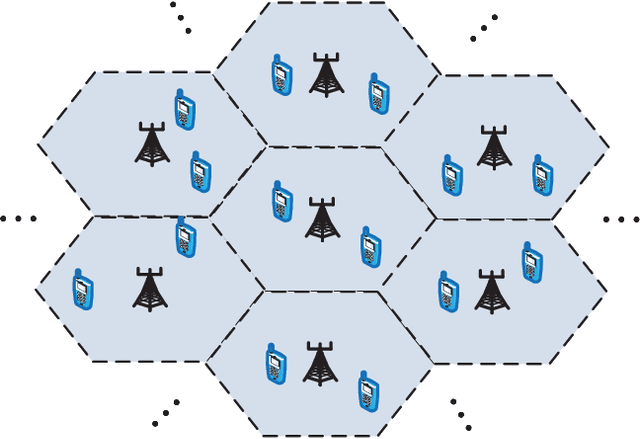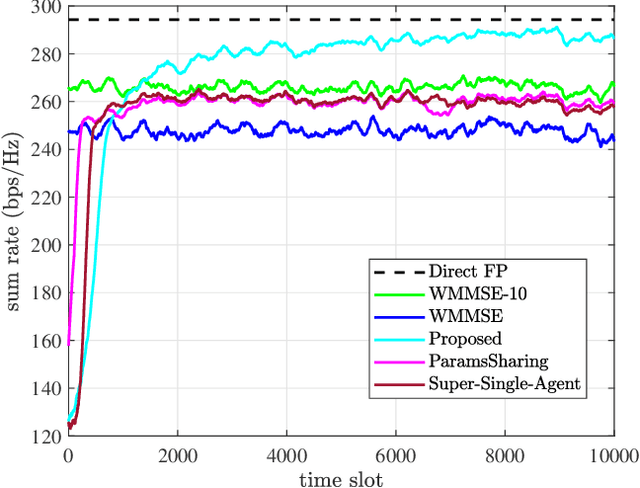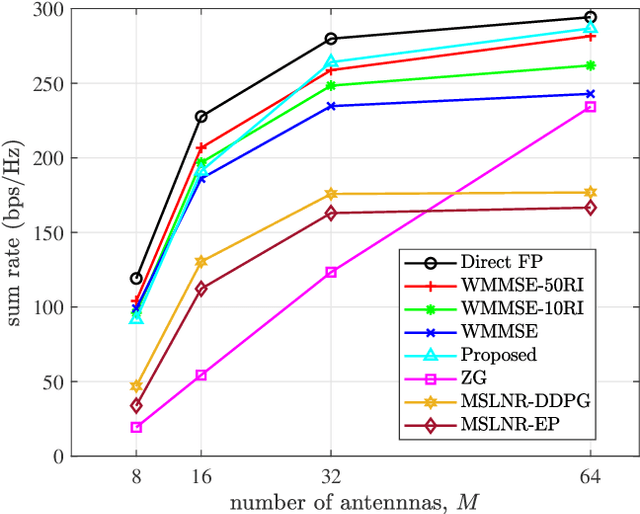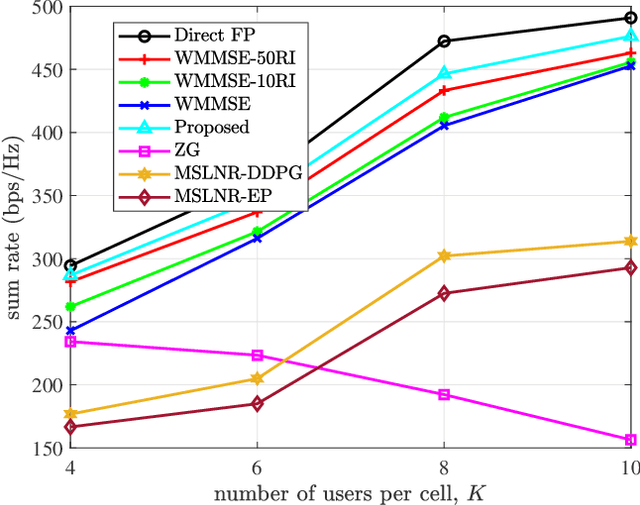Jungang Ge
User Association and Coordinated Beamforming in Cognitive Aerial-Terrestrial Networks: A Safe Reinforcement Learning Approach
Feb 19, 2025Abstract:Cognitive aerial-terrestrial networks (CATNs) offer a solution to spectrum scarcity by sharing spectrum between aerial and terrestrial networks. However, aerial users (AUs) experience significant interference from numerous terrestrial base stations (BSs). To alleviate such interference, we investigate a user association and coordinated beamforming (CBF) problem in CATN, where the aerial network serves as the primary network sharing its spectrum with the terrestrial network. Specifically, we maximize the sum rate of the secondary terrestrial users (TUs) under the interference temperature constraints of the AUs. Traditional iterative optimization schemes are impractical due to their high computational complexity and information exchange overhead. Although deep reinforcement learning (DRL) based schemes can address these challenges, their performance is sensitive to the weights of the weighted penalty terms for violating constraints in the reward function. Motivated by these issues, we propose a safe DRL-based user association and CBF scheme for CATN, eliminating the need for training multiple times to find the optimal penalty weight before actual deployment. Specifically, the CATN is modeled as a networked constrained partially observable Markov game. Each TU acts as an agent to choose its associated BS, and each BS acts as an agent to decide its beamforming vectors, aiming to maximize the reward while satisfying the safety constraints introduced by the interference constraints of the AUs. By exploiting a safe DRL algorithm, the proposed scheme incurs lower deployment expenses than the penalty-based DRL schemes since only one training is required before actual deployment. Simulation results show that the proposed scheme can achieve a higher sum rate of TUs than a two-stage optimization scheme while the average received interference power of the AUs is generally below the threshold.
Towards Symbiotic SAGIN Through Inter-operator Resource and Service Sharing: Joint Orchestration of User Association and Radio Resources
Apr 25, 2024



Abstract:The space-air-ground integrated network (SAGIN) is a pivotal architecture to support ubiquitous connectivity in the upcoming 6G era. Inter-operator resource and service sharing is a promising way to realize such a huge network, utilizing resources efficiently and reducing construction costs. Given the rationality of operators, the configuration of resources and services in SAGIN should focus on both the overall system performance and individual benefits of operators. Motivated by emerging symbiotic communication facilitating mutual benefits across different radio systems, we investigate the resource and service sharing in SAGIN from a symbiotic communication perspective in this paper. In particular, we consider a SAGIN consisting of a ground network operator (GNO) and a satellite network operator (SNO). Specifically, we aim to maximize the weighted sum rate (WSR) of the whole SAGIN by jointly optimizing the user association, resource allocation, and beamforming. Besides, we introduce a sharing coefficient to characterize the revenue of operators. Operators may suffer revenue loss when only focusing on maximizing the WSR. In pursuit of mutual benefits, we propose a mutual benefit constraint (MBC) to ensure that each operator obtains revenue gains. Then, we develop a centralized algorithm based on the successive convex approximation (SCA) method. Considering that the centralized algorithm is difficult to implement, we propose a distributed algorithm based on Lagrangian dual decomposition and the consensus alternating direction method of multipliers (ADMM). Finally, we provide extensive numerical simulations to demonstrate the effectiveness of the two proposed algorithms, and the distributed optimization algorithm can approach the performance of the centralized one.
Hierarchical Cognitive Spectrum Sharing in Space-Air-Ground Integrated Networks
Dec 13, 2023



Abstract:In space-air-ground integrated networks (SAGINs), cognitive spectrum sharing has been regarded as a promising solution to improve spectrum efficiency by enabling a secondary network to access the spectrum of a primary network. However, different networks in SAGIN may have different quality of service (QoS) requirements, which can not be well satisfied with the traditional cognitive spectrum sharing architecture. For example, the aerial network typically has high QoS requirements, which however may not be met when it acts as a secondary network. To address this issue, in this paper, we propose a hierarchical cognitive spectrum sharing architecture (HCSSA) for SAGINs, where the secondary networks are divided into a preferential one and an ordinary one. Specifically, the aerial and terrestrial networks can access the spectrum of the satellite network under the condition that the caused interference to the satellite terminal is below a certain threshold. Besides, considering that the aerial network has a higher priority than the terrestrial network, we aim to use a rate constraint to ensure the performance of the aerial network. Subject to these two constraints, we consider a sum-rate maximization for the terrestrial network by jointly optimizing the transmit beamforming vectors of the aerial and terrestrial base stations. To solve this non-convex problem, we propose a penalty-based iterative beamforming (PIBF) scheme that uses the penalty method and the successive convex approximation technique. Moreover, we also develop three low-complexity schemes by optimizing the normalized beamforming vectors and power control. Finally, we provide extensive numerical simulations to compare the performance of the proposed PIBF scheme and the low-complexity schemes. The results also demonstrate the advantages of the proposed HCSSA compared with the traditional cognitive spectrum sharing architecture.
Active RIS Enhanced Spectrum Sensing for Cognitive Radio Networks
Nov 28, 2023



Abstract:In opportunistic cognitive radio networks, when the primary signal is very weak compared to the background noise, the secondary user requires long sensing time to achieve a reliable spectrum sensing performance, leading to little remaining time for the secondary transmission. To tackle this issue, we propose an active reconfigurable intelligent surface (RIS) assisted spectrum sensing system, where the received signal strength from the interested primary user can be enhanced and underlying interference within the background noise can be mitigated as well. In comparison with the passive RIS, the active RIS can not only adapt the phase shift of each reflecting element but also amplify the incident signals. Notably, we study the reflecting coefficient matrix (RCM) optimization problem to improve the detection probability given a maximum tolerable false alarm probability and limited sensing time. Then, we show that the formulated problem can be equivalently transformed to a weighted mean square error minimization problem using the principle of the well-known weighted minimum mean square error (WMMSE) algorithm, and an iterative optimization approach is proposed to obtain the optimal RCM. In addition, to fairly compare passive RIS and active RIS, we study the required power budget of the RIS to achieve a target detection probability under a special case where the direct links are neglected and the RIS-related channels are line-of-sight. Via extensive simulations, the effectiveness of the WMMSE-based RCM optimization approach is demonstrated. Furthermore, the results reveal that the active RIS can outperform the passive RIS when the underlying interference within the background noise is relatively weak, whereas the passive RIS performs better in strong interference scenarios because the same power budget can support a vast number of passive reflecting elements for interference mitigation.
Deep Reinforcement Learning for Distributed Dynamic Coordinated Beamforming in Massive MIMO Cellular Networks
Mar 24, 2023



Abstract:To accommodate the explosive wireless traffics, massive multiple-input multiple-output (MIMO) is regarded as one of the key enabling technologies for next-generation communication systems. In massive MIMO cellular networks, coordinated beamforming (CBF), which jointly designs the beamformers of multiple base stations (BSs), is an efficient method to enhance the network performance. In this paper, we investigate the sum rate maximization problem in a massive MIMO mobile cellular network, where in each cell a multi-antenna BS serves multiple mobile users simultaneously via downlink beamforming. Although existing optimization-based CBF algorithms can provide near-optimal solutions, they require realtime and global channel state information (CSI), in addition to their high computation complexity. It is almost impossible to apply them in practical wireless networks, especially highly dynamic mobile cellular networks. Motivated by this, we propose a deep reinforcement learning based distributed dynamic coordinated beamforming (DDCBF) framework, which enables each BS to determine the beamformers with only local CSI and some historical information from other BSs.Besides, the beamformers can be calculated with a considerably lower computational complexity by exploiting neural networks and expert knowledge, i.e., a solution structure observed from the iterative procedure of the weighted minimum mean square error (WMMSE) algorithm. Moreover, we provide extensive numerical simulations to validate the effectiveness of the proposed DRL-based approach. With lower computational complexity and less required information, the results show that the proposed approach can achieve comparable performance to the centralized iterative optimization algorithms.
 Add to Chrome
Add to Chrome Add to Firefox
Add to Firefox Add to Edge
Add to Edge